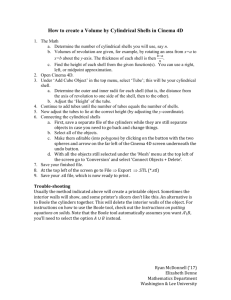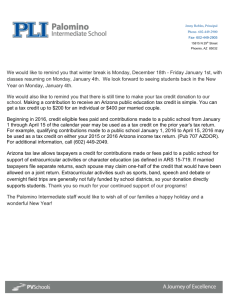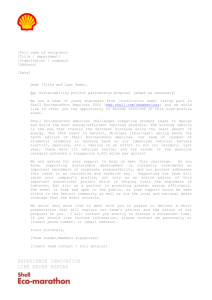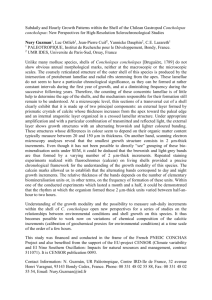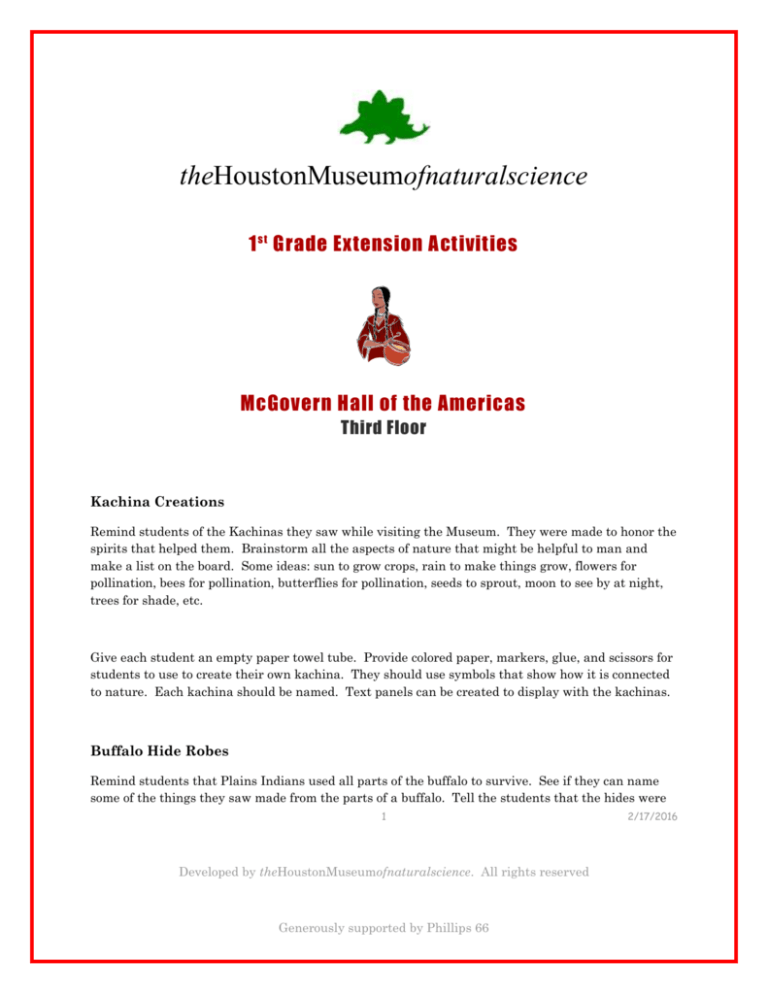
theHoustonMuseumofnaturalscience
1 s t Grade Extension Activities
McGovern Hall of the Americas
Third Floor
Kachina Creations
Remind students of the Kachinas they saw while visiting the Museum. They were made to honor the
spirits that helped them. Brainstorm all the aspects of nature that might be helpful to man and
make a list on the board. Some ideas: sun to grow crops, rain to make things grow, flowers for
pollination, bees for pollination, butterflies for pollination, seeds to sprout, moon to see by at night,
trees for shade, etc.
Give each student an empty paper towel tube. Provide colored paper, markers, glue, and scissors for
students to use to create their own kachina. They should use symbols that show how it is connected
to nature. Each kachina should be named. Text panels can be created to display with the kachinas.
Buffalo Hide Robes
Remind students that Plains Indians used all parts of the buffalo to survive. See if they can name
some of the things they saw made from the parts of a buffalo. Tell the students that the hides were
1
Developed by theHoustonMuseumofnaturalscience. All rights reserved
Generously supported by Phillips 66
2/17/2016
used to make the tipi, clothing, and the storages bags. Ask them if they remember the cape
decorated with symbols to indicate that it belonged to a warrior.
Before beginning the activity, cut a large paper grocery sack up the middle on the writing side. Cut
off the bottom flap and fold the bag flat. Punch a hole at the top of each side of the center opening
and thread a piece of yarn through it to create a way to tie it around the child’s neck. Make enough
capes for each child. Give each student a pre-cut paper bag cape. Allow the students to use markers
or Tempera paint to create designs on their cape using repeating patterns and geometric shapes for
their designs. When the capes are dry, students can crumple them several times to make them look
like hides.
Using our Resources
Remind students that once people had to use natural resources for everything, including clothing,
toys, bowls, houses, etc. Remind students that they saw a ceramic model of a ball game played 2,000
years ago, with a rubber ball made from the rubber plants found in the jungle. Tell students that
today they are going to create their own game with just the resources that you give them. Divide the
class into several small groups. Give each group a rubber ball, seven craft sticks, five paper clips,
and three pipe cleaners. Challenge the students to create a new game using only these “natural”
resources.
Beaded Beauty
Recall with the students that beads have been an important part of trading for hundreds of years.
Those same beads were then used to decorate clothing and shoes. Ask students if they remember
seeing the vests, dresses, and moccasins decorated with beadwork. Remind them that often times
the Plains Indians created patterns with those beads.
Give each student a long pipe cleaner. Provide a variety of colored and patterned beads for the class.
Instruct the students to create a pattern with their beads on the pipe cleaner. These can be used to
decorate the capes or students can attach them in the lace holes of their tennis shoes.
2
Developed by theHoustonMuseumofnaturalscience. All rights reserved
Generously supported by Phillips 66
2/17/2016
Hall of Ancient Egypt
Third Floor
The Life and Times of ME!
Ask the students to recall the large timeline they saw in the Hall of Ancient Egypt. Explain that a
timeline is a list of events in the order they happened. Tell the students they will be creating their
own timelines which will depict their life. They should choose 4 – 6 stages in their lives that they
would like to highlight. Encourage the students to work with their parents to create a timeline. They
can add pictures or memories of major points in their life. Display them around the room.
Model of Me
Give each student a large lump of clay. Ask them to create a statue of themselves. Explain that, like
the statue they saw in the museum, they should try to be as detailed as they can. Students should
notice that they will spend a lot of time perfecting their statue, a lot like the overseer with his
personal statue.
My Shabti
While visiting the Hall of Ancient Egypt students learned that Shabti were put inside tombs so that
they could do all the work in the afterlife. Ask the students to write a short story about how they
would feel if they had a Shabti. Would they give their Shabti all of their chores or homework? While
the Shabti was doing all the work, what would the student do to pass the time? Have the students
share their stories with the class.
Maps of the World
Print out a Map of Ancient Egypt. Ask the students to label Alexandria, Memphis, the Nile River
and the desert areas. Students should provide a compass rose so that North, East, South and West
are noted.
3
Developed by theHoustonMuseumofnaturalscience. All rights reserved
Generously supported by Phillips 66
2/17/2016
Strake Hall of Malacology
Second Floor
Sneaky Snails
Ask the students where they look when they are searching for snails. Explain that snails like to live
around shrubs or flowers because they have leaves to eat and damp shade to keep their bodies moist.
Ask students if they remember seeing a snail while visiting the Museum. It moves along using the
bands of muscles in its foot. The trail of slime helps it glide smoothly and protects the snail from
anything harmful that might be in its path.
Give each student a piece of large shell macaroni. Talk about how the shell of the snail is similar in
shape to the macaroni and the soft body of the snail would fit inside for protection. Demonstrate
how the body can be made by rolling a small ball of modeling clay, flattening the bottom, and
sticking the macaroni shell on the top. Mold the small ball to create the head and stretch the foot
coming out of the shell. Allow the students to make their own snails. Tempera paint or markers can
be used to decorate the shells and small pieces of pipe cleaners or tooth picks may be added to make
antennae. Allow the students to make up a “scientific” name for their snail, label them, and display
them in the classroom.
Cowrie Problems
Ask the students if they remember the shells they saw at the Museum that were once used for
money, called cowrie shells. Ask them if they remember that some of the shells also looked like little
animals or had designs on the shells. Give students large shell macaroni and markers. Allow them
to color and decorate 10-20 shells. When all the shells are decorated, ask the students to create
addition and subtraction problems by gluing down groups of decorated shells along with the
operational symbols. A number sentence should accompany them.
The Shell Game
4
Developed by theHoustonMuseumofnaturalscience. All rights reserved
Generously supported by Phillips 66
2/17/2016
Bring in a large variety of shells for students to look at. Provide each student with a handful of
paper clips. Ask each student to pick a shell. Ask them to predict how many paper clips long the
shell will be. Have them write their prediction in the chart and then “measure” the shell and record
its measurement. Allow the students to pick another shell and repeat the process. Continue this
with seven shells. By the end of the activity, students should make more accurate predictions.
Shell Number
Prediction
Paper Clip Length
Undergoing a Change
Give each student a die cut shape of a shell. Tell the students that they are going to transform their
shell into something else. Tell the students to glue the shell to a piece of white paper in any random
direction. Then tell students to use crayons or markers to all details to the shell to transform it into
something totally different. For example, a scallop shell might become a butterfly or a whelk shell
might become a rocket ship. No parts may be cut off the shell, but anything can be added. Allow
each student time to talk about his or her picture.
Beachcombing
Tell the students that when you look for shells at the beach, you are beachcombing. Suppose you
were walking on the beach and found an interesting shell. Design the shell you would like to find.
Ask the students to think about some of the repeating patterns they saw on the shells at the
Museum. Ask them to create their shell and write a story about their day at the beach.
5
Developed by theHoustonMuseumofnaturalscience. All rights reserved
Generously supported by Phillips 66
2/17/2016
6
Developed by theHoustonMuseumofnaturalscience. All rights reserved
Generously supported by Phillips 66
2/17/2016
Cullen Hall of Gems and Minerals
Second Floor
Sparkling Cave
Remind students that in the Museum they saw many gems and minerals that were shaped like
spheres, rectangular prisms, cylinders, cones, cubes, triangles, and rectangles. Talk about how some
were only one color, some were various shades of color, and others were many colors.
Tell students that today they are going to become mineralogists. They have discovered a new
mineral. Give each student a tangram sheet that has not been cut apart. Allow them to color the
pieces or use them as templates to cut the shapes from a variety of construction paper colors. Give
each student a paper plate on which to arrange their pieces and glue them down. Encourage
students to bend the shapes to make two and three dimensional models. Color the outside of the
paper plate black or grey so that it looks like a geode. Arrange all of the new minerals on a large
sheet of black paper to resemble a cave and hang it on the wall.
7
Developed by theHoustonMuseumofnaturalscience. All rights reserved
Generously supported by Phillips 66
2/17/2016
Farish Hall of Texas Wildlife
Second Floor
Herbivore or Carnivore
Remind students that all animals eat either plants, meat, or both. Pass out toy animals, or
pictures of animals that represent those seen in the Farish Hall of Texas Wildlife. In groups,
have students categorize the animals as either a herbivore, a carnivore or both. Then, have
students work together as a class to describe the similar characteristics of herbivores and
carnivores.
Tell students that they are going to create a new animal. All they know about it is whether it
eats meat or plants. Have students cut out magazine pictures to create their new animal based
on the adaptations it would need to survive.
Habitat Hunt
Tell students that animals use their surroundings to help them survive. Some can climb
mountains, others can hold their breath for a long time, and still others build houses out of
sticks and twigs.
Students are going to be assigned an animal. Give each student or student group a toy animal,
or an image of the animal they are assigned. They need to build a habitat for this animal that
they think will help it survive. They can use a shoe box or draw the habitat on paper.
Once students have finished building their habitats, take the animal pictures or models back.
Mix them up and place them in student habitats at random. Have groups determine whether
their animal could survive in its new habitat. If not, why not? What would they need to change
to survive?
Food Chain
Remind students that the grass is a producer, because it uses the energy it receives from the
sun to produce food for the animals. Use a large sheet of construction paper or butcher paper
and split students into groups. Have them draw grass at the bottom of the paper. Then, have
8
Developed by theHoustonMuseumofnaturalscience. All rights reserved
Generously supported by Phillips 66
2/17/2016
them create a food chain based on animals they saw in the Farish Hall of Texas Wildlife. Their
food chain should include at least different three animals.
Extinct and Vanishing Species
The Farish Hall of Texas Wildlife represents Texas as it looked prior to human involvement.
Remind students that there are some animals that have moved out of Texas and can no longer
be found.
Have students brainstorm different reasons why animals might have left Texas. Tell them to
think about their own neighborhood and city, and whether the animals they saw in the exhibit
could survive in them. Then, ask students to brainstorm different ways to bring some of these
animals back.
As a class, decide on the top two or three ideas. These can be writing a letter to a
Congressperson, cleaning up litter from natural habitats, or anything similar. Work as a class
to carry out these actions.
9
Developed by theHoustonMuseumofnaturalscience. All rights reserved
Generously supported by Phillips 66
2/17/2016
Hamman Hall of Texas Coastal Ecology
Second Floor
Trap n’ Go
Oysters, like the ones you saw in the oyster reef in the Upper Coast section, are filter feeders.
This means that they bring ocean water in over their gills and “trap” small particles of yummy
things that they can eat. Many creatures that live in our ocean use filter feeding to get their
food. In this activity, students will create their own “filter feeders” to trap food.
You will need:
-
Miscellaneous waterproof recyclables (plastic bottles, caps, pipecleaners, plastic bags,
string, cloth, etc.). You may need to cut these if students require it.
Things to hold the filter together: duct tape, binder clips, clothespins
Tank of water big enough for a student to move their filter around
Various sizes of particles: peas, beans, uncooked rice
Minute timer, paper, and pen
Students should design a filter using the materials provided. Their goal is to capture as many
food particles as possible in one minute. Encourage them to think about the size of their food
particles and how they could be captured: Can we trap them with small enough holes? Could
they be caught and held by branches on the inside of the filter?
After you have tested each filter, discuss with students how tiny pollutants released into the
water might affect organisms that get their food by filter feeding.
Stop the Cycle
In one of the videos students saw in the exhibit, the narrator talks about the “never ending
cycle” of picking up trash that has ended up in the ocean. Discuss with students the importance
of recycling and using proper trash receptacles. Have students work as a team to design a
banner that can be displayed in the hallway illustrating environmentally friendly techniques.
10
Developed by theHoustonMuseumofnaturalscience. All rights reserved
Generously supported by Phillips 66
2/17/2016
Frensley Hall of African Wildlife
Second Floor
My Home is Better Than Your Home!
Ask the students if they remember some of the homes they saw for animals while they were visiting
the Museum. Ask them to describe some of the animal homes they saw. Give students pictures of
animals that they will be familiar with, such as birds, ants, beavers, bears, lions, penguins, etc. Ask
them to create a home for that animal. They may make a three dimensional shelter or draw a
picture and put their animal inside. Allow the students to show their homes and tell why the home
is best for that particular animal. Create a gallery of homes in the classroom.
Living/Nonliving
Provide a large number of magazines for the students to cut up. Children’s magazines will work best
for this activity. Give each child a large sheet of manila paper separated in down the middle with a
line and the words “Living” and “Nonliving”. Allow students time to complete their charts. They
should be able to explain why each object is categorized as it is.
Oh, My Okapi
Ask students if they remember the Okapi they saw in the Congo exhibit. See if the students can
name the three animals that make up the Okapi. Allow the students to draw or cut out three
different animals. Cut the head, body, legs, and tail off all three animals. Use the body parts to
create an original animal. Students should be allowed to name their animal.
Animal Population
Ask the students to brainstorm a list of animals that live in Africa. Beside each animal, write some
of its characteristics. Make a chart of the animals grouped by characteristics such as color, body
covering, number of legs, kinds of feet, etc. Challenge students to come up with as many varied
combinations as possible.
11
Developed by theHoustonMuseumofnaturalscience. All rights reserved
Generously supported by Phillips 66
2/17/2016
Provide groups of students with a collection of plastic animals. Allow the small group to arrange the
animals into a variety of groups according to their attributes or characteristics.
12
Developed by theHoustonMuseumofnaturalscience. All rights reserved
Generously supported by Phillips 66
2/17/2016
The Morian Hall of Paleontology
First Floor
Fossil Finds
Ask the students if any of them saw a fossil while they were at the Museum. Ask them what kinds
of fossils they saw. They may suggest bones, teeth, wood, leaves, shells, sea creatures, etc. Tell the
students that today they are going to become paleontologists. Bury small chicken bones, plastic
teeth, pieces of wood, shells, leaves, etc. in a low, flat box filled with uncooked rice. Give the
students small plastic spoons to use as shovels. Allow the students to dig in the beans to uncover
their fossils. Let them draw their findings and write a few sentences about it in a Field Journal
made by stapling a few pieces of paper together with a cover.
Flattened Fossils
To demonstrate how some fossils are flattened between rock layers, create a model of the Earth’s
rock layers using tortillas and a variety of spreadable food (Note: do not use peanut butter because
of possible food allergies). On one tortilla, spread pudding. On another, spread jelly, marshmallow
cream, or something similar. The teacher should create a clay dinosaur to place between the two
tortillas. Press the tortillas together. Cut the tortilla in half so the layers can easily been seen.
Press the tortillas together hard enough to break the clay dinosaur to demonstrate how fossils can be
crushed by the pressure of the rock layers.
What Happened?
Remind the students that at the Museum they saw a drawing of what scientists believe happened to
the dinosaurs. Ask the students to draw their own prediction about what may have happened to the
dinosaurs and present it to the class.
13
Developed by theHoustonMuseumofnaturalscience. All rights reserved
Generously supported by Phillips 66
2/17/2016
New Discoveries
Print out pictures of a variety of dinosaurs. Cut the dinosaurs into four pieces: head and neck, body,
legs, and tail. Allow students to pick four body parts that do not normally go together and glue them
on a sheet of white paper to create a new species of dinosaur. They may add to their picture to make
the parts connect. Allow students to draw the environment in which their dinosaur lives. Tell the
students to name their dinosaur.
Digging for Dinosaurs
Buy several dinosaur assembly kits. Take them apart and mix all of the “bones” together. Bury
them in a large box filled with uncooked rice. Give each student a plastic spoon and allow them to
“dig” in the rice until they find a bone. Ask students to glue their bone onto a sheet of paper and
create the dinosaur they think the bone would have belonged to. Allow the students to name their
dinosaur and display them.
Panning for Dinosaurs
Collect a variety of items (shells, leaves, rocks, fern fronds, plants, wood, pine needles, pottery
shards, etc.) and combine them with sand or loose soil. Create a sifting box by nailing medium gage
wire screen over a wooden box frame or use a kitchen sieve. Pour the dirt with the items mixed in it
onto the wire screen and shake it gently over a large piece of newspaper. Allow the dirt to sift out
while the larger items remain on the screen. Collect the items and allow the students to draw the
setting in which these items would be found by including them in their picture. When the students
show their picture, point out the many different ways items were grouped to create the variety of
pictures.
14
Developed by theHoustonMuseumofnaturalscience. All rights reserved
Generously supported by Phillips 66
2/17/2016
Wiess Energy Hall
First Floor
Moving Continents
Remind students of the touch screen demonstration of how the Earth’s landforms moved for millions
of years to form the continents that we know today. Explain that the continents continue to move on
a layer of the Earth’s crust, 60 to 580 miles below its surface called the asthenosphere. Demonstrate
with two pieces of craft foam cut in the shape of a continent and a dollop of shaving cream on a sheet
of waxed paper. Show how the continents move on this layer. Push the pieces of foam close together,
then on top of each other, to show how the movement of the Earth creates a mountain ridge. Give
each student a 5”X5” piece of craft foam. Allow them to create their own continent shape. On a
sheet of waxed paper, give each student a small amount of shaving cream (without menthol). Allow
them to experiment with the movement of continents and the creation of mountain ridges.
Welcome to My World
Remind the students that at one time the continents all fit together in one large land mass. Give
each student a sheet of craft foam. Allow them to create their own world by drawing at least four
large landforms next to each other like a puzzle. Students will cut out the landforms and lay them
on a large sheet of blue paper so that the cut pieces fit together like a completed puzzle. Allow the
students to slowly slide the pieces apart to experience plate tectonics. When they are separated far
enough, ask students to glue the continents down. They should name their continents and bodies of
water.
Do You Have the Energy?
Provide a variety of magazines and ask students to cut out pictures of things that are powered by
electricity. Ask the students to imagine that they had no electricity and had to find an alternative
way to power things such as lights, fans, televisions, ovens, etc. Talk with the students about some
of the alternative fuels they saw at the Museum. Ask the students to redesign the item that they cut
out to show how it would be powered. For example, a fan might be turned by the wind.
15
Developed by theHoustonMuseumofnaturalscience. All rights reserved
Generously supported by Phillips 66
2/17/2016
Alfred C. Glassell Jr. Hall
First Floor, Main Entrance
Fish Life Cycle
Tell students that they are going to be studying the basic fish life cycle. Give them a blank sheet of
construction paper, cotton balls, and various other craft supplies. In this activity, students will be focusing on
three stages: egg, juvenile and adult. Using the craft supplies, have students draw out the three stages on
their paper. Cotton balls glued to the paper can be used to represent eggs.
Survival of the Fish-iest
Tell students that they are going to be responsible for caring for their very own pet fish. Give each student
either a paper fish or a plastic fish toy. Students are responsible for creating a home for their fish, either on
paper or out of a shoe box. Remind students that they should consider what the fish needs to eat, whether it
needs somewhere to hide, and how much space it needs.
Extension: If you have the means, you may want to purchase live fish for the classroom and have the
students help with the construction and set-up of the tank, as well as their continued care.
Which Fish is This?
Put pictures of two different fish on the board, such as a Marlin and a Trout. Read off a variety of descriptive
phrases (such as: “This fish has a pointed nose”, or “This fish probably prefers shallow water”) and have the
students guess which fish you’re describing.
16
Developed by theHoustonMuseumofnaturalscience. All rights reserved
Generously supported by Phillips 66
2/17/2016
The Welch Chemistry Hall
Lower Level
Changes in Matter
Briefly discuss with students the differences between a solid, a liquid, and a gas. As a class, come up
with a list of as many different solids, liquids, and gases as possible. Then ask students if they think
matter can change from one form to another. Can a solid become a liquid or a gas? Can a gas become
a solid?
Show students an ice cube. Ask them what they think will happen if it is left out in the sun. Then,
ask them what happens to puddles after it hasn’t rained in a long time. Explain that in this case
water is changing from a solid to a liquid and then a gas. Have students draw this process.
Light, Heat, and Sound Energy
Remind students that energy is everywhere. Tell them that they are going to learn about three
different kinds of energy: light, heat and sound energy. Students will take on the role of detectives
and explore the classroom, finding as many different examples of each type of energy as they can. If
possible, students can be led outside to continue their investigations. Once finished, lead a discussion
about the different types of energy they observed and why it is important.
17
Developed by theHoustonMuseumofnaturalscience. All rights reserved
Generously supported by Phillips 66
2/17/2016
Solar System
Outside Main Entrance
Space Explorers
Allow the students to create their own space suits for a mission to another planet. Give each student
a large paper grocery sack and a thin white paper plate. Instruct the students to cut out the center
section of the paper plate. Cut a contrasting hole of the same size in the paper bag about an inch
from the bottom. Use liquid glue to attach the plate to the bag (Note: Be sure that the students’
faces show out of the hole.) Allow students time to decorate their space helmets. They should
include a patch commemorating their mission.
18
Developed by theHoustonMuseumofnaturalscience. All rights reserved
Generously supported by Phillips 66
2/17/2016

